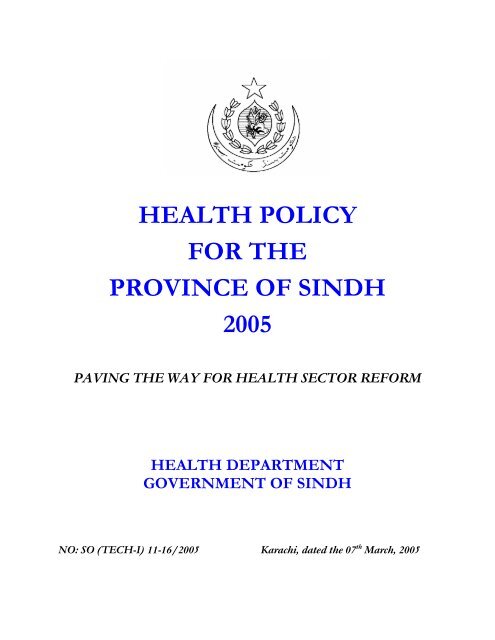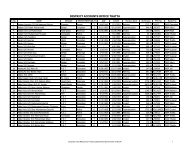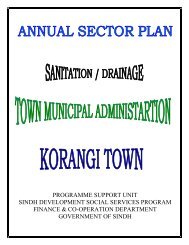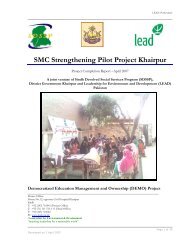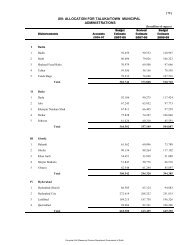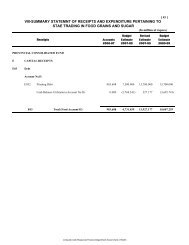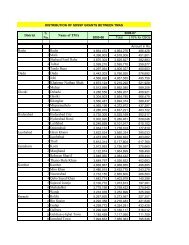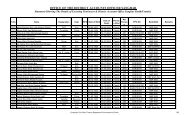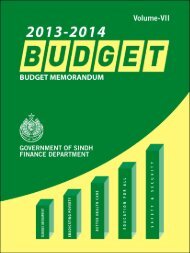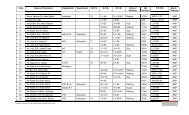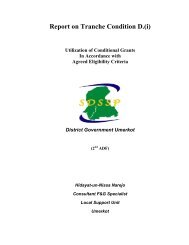HEALTH POLICY FOR THE PROVINCE OF SINDH 2005 - Finance ...
HEALTH POLICY FOR THE PROVINCE OF SINDH 2005 - Finance ...
HEALTH POLICY FOR THE PROVINCE OF SINDH 2005 - Finance ...
Create successful ePaper yourself
Turn your PDF publications into a flip-book with our unique Google optimized e-Paper software.
<strong>HEALTH</strong> <strong>POLICY</strong><br />
<strong>FOR</strong> <strong>THE</strong><br />
<strong>PROVINCE</strong> <strong>OF</strong> <strong>SINDH</strong><br />
<strong>2005</strong><br />
PAVING <strong>THE</strong> WAY <strong>FOR</strong> <strong>HEALTH</strong> SECTOR RE<strong>FOR</strong>M<br />
<strong>HEALTH</strong> DEPARTMENT<br />
GOVERNMENT <strong>OF</strong> <strong>SINDH</strong><br />
NO: SO (TECH-I) 11-16/<strong>2005</strong> Karachi, dated the 07 th March, <strong>2005</strong>
2<br />
I N D E X<br />
Foreword (Advisor Health) 5<br />
Preface (Secretary Health) 6<br />
Mission Statement 7<br />
Preamble 8<br />
I Introduction 9<br />
• Major Determinants of ill Health.<br />
• The Case for Inter-Sectoral Collaboration<br />
• The Health and Poverty Nexus.<br />
• The Health Scenario and Infrastructure in Sindh<br />
• The Lady Health Worker’s Programme.<br />
• Low level of financing for the Health Sector<br />
• Major Health Problems of Sindh<br />
II The Way Forward: Key Areas of the Health Policy 11<br />
(A).<br />
SPECIFIC OBJECTIVES<br />
1 Control of Communicable diseases 11<br />
• Tuberculosis<br />
• Vaccine-preventable illness and Polio eradication<br />
• Malaria and Leishmaniasis<br />
• Blood Safety and Control of HIV/AIDS<br />
• Hepatitis B and C<br />
2 Control of Non-communicable diseases 13<br />
• Cardiac disease, Diabetes, Cancers, Mental Illnesses, Genetic disorders,<br />
Snake bite and Dog bite.<br />
• Prevention of Blindness (Vision 2020) Programme in Sindh<br />
3 To improve Maternal and Child Health 14<br />
4 Countering Malnutrition 15<br />
5 To ensure Road Safety 15
3<br />
6 Development of District Health System 16<br />
• Need for Capacity Building and to remove professional and<br />
managerial deficiencies in District Health System<br />
• Incentive Packages for Rural Health Services<br />
• Implementation of the Basic Development Needs concept<br />
• Strengthening Health Management Information System<br />
7. Regulation of the Private Health Sector 19<br />
8. Reforming Medical Education 19<br />
9. Reforming Medicolegal and Allied Services 20<br />
10. Training of Nurses and Paramedics 21<br />
11. Emergency Preparedness & response to epidemics 21<br />
12. School Health Services 22<br />
13. Need for development of career structure of Health Professionals 23<br />
14. Ensuring transparency in procurement 23<br />
15. Reviving devolution plan & removing professional and<br />
Administrative deficiencies 23<br />
16. Environmental Health 24<br />
17. Drug Abuse Control 25<br />
18. Health Legislation 26<br />
19. Reviving Sindh Health Foundation 26<br />
20. Regularization of Teaching Hospitals 26<br />
21. Financing of Health Sector 27<br />
22. Capacity Building for Health Policy 27<br />
(B). GENERAL OBJECTIVES 27<br />
III C O N C L U S I O N 28<br />
IV P R A Y 28<br />
Annex-I: The Millennium Development Goals 29
4<br />
PROVINCIAL <strong>HEALTH</strong> <strong>POLICY</strong><br />
<strong>2005</strong><br />
A U T H O R S<br />
1. DR. Shafquat Hussain Abbasi<br />
2. DR. G. N. Kazi<br />
3. DR. M. Jamil Mughal<br />
C O N T R I B U T O R S<br />
1. DR. Kamil Rajper<br />
2. DR. Sajan Memon<br />
3. DR. Noor-ud-din Qureshi<br />
4. DR. Fateh M. Khan<br />
5. DR. Sher Shah Syed<br />
6. DR. (Capt) Abdul Majid
CHIEF MINISTER <strong>SINDH</strong><br />
CHIEF MINISTER HOUSE KARACHI<br />
5<br />
MESSAGE<br />
Pakistan achieved independence in 1947 and currently has a population of<br />
around 150 million, of which Sindh share is 34 million. In this new era, our country faces<br />
enormous challenges with regard to the health state and health indicators. The state of<br />
maternal & child health indicators stands highest in Asia.<br />
Under the constitution, health is both a Federal and Provincial responsibility<br />
as it falls in the concurrent list. Policy formulation comes essentially under the purview of<br />
the Federal Government; however, remaining within the framework of the National Policy,<br />
the provinces can draw up their own policies. Apart from actual health services delivery, the<br />
provincial health authorities are also responsible for planning and management of human<br />
and physical resources and allocation of resources to the lower levels in collaboration with<br />
the departments for <strong>Finance</strong> and Planning & Development.<br />
I have gone through this Provincial Health Policy of Health Department and<br />
found it a complete and comprehensive document leading to the way forward to provide<br />
protection to ailing population against hazardous diseases, promoting pubic health,<br />
upgrading curative health facilities, enhancing equity, efficiency & affectivity in health sector.<br />
The identified key areas are justified ad reflects the best intentions of Health Department<br />
making efforts to eliminate the communicable and non communicable diseases form the<br />
community, Moreover, the idea of reforming Medical Education, Legislation and revamping<br />
of Medical legal Services, to control private health sector, Quackery, Saniasi baba and<br />
irrational publicity of spurious and misleading drugs, is also commendable, which will cause<br />
minimum hardship to the ailing populations.<br />
In the last, I endorse the contents of the health policy, congratulating and<br />
acknowledging the efforts of Mr. Faisal Malik, Prof. Dr. Noshad A. Shaikh, Dr. Shafquat<br />
Hussain Abbasi and Dr. Muhammad Jamil Mughal, for formulating this policy.<br />
(DR. ARBAB GHULAM RAHIM)
F O R E W O R D<br />
6<br />
With a population of around 34 million, Sindh is the second most populous province<br />
of Pakistan. At the turn of the new millennium, our country and province faces enormous<br />
challenges with regard to its health sector. Of special concern is the state of maternal and<br />
child health indicators which remain quite dismal owing largely to gender inequity and lower<br />
access of females to health, population welfare and education services.<br />
A health policy summarizes the vision, goals, objectives and targets of the<br />
government with regard to its health sector, which justifiably aims at an improvement in the<br />
health status and the overall quality of life of its citizens. While framing a health policy it is<br />
pertinent to take into account the socio-economic factors and also delineate the role of other<br />
sectors that have a direct bearing on health. It appears that Health Policy Formulation does<br />
not receive the incisive and painstaking approach in its development process that is<br />
warranted by our health situation. In the process, key considerations are overlooked that lead<br />
to development of majors gaps, which manifest themselves during the implementation<br />
phase. Furthermore, it appears that successive policies were either overly ambitious, not<br />
backed up by the requisite financing, or their implementation did not keep pace with policy.<br />
The Government of Sindh is committed to improve the quality of health<br />
services provided to our masses and therefore every effort has been made to draw up<br />
a workable policy, followed by an implementation plan and backed up by adequate<br />
resources so that a visible difference can be brought about in the quality of our<br />
medical, nursing and paramedical education, health services delivery and collaboration<br />
with other sectors to the ultimate benefit of the people of this province.<br />
FAISAL MALIK<br />
ADVISER TO CHEF MINISTER <strong>SINDH</strong><br />
<strong>FOR</strong> <strong>HEALTH</strong>
P R E F A C E<br />
7<br />
It is after a long period of time that the Provincial Health Policy has been announced<br />
in Sindh in order to give a clear sense of direction to our senior and mid-level managers. The<br />
provincial policy is fully in conformity and in line with the National Health Policy. I may add<br />
that although the National Health Policy is very sound, pragmatic and workable, it leaves a<br />
lot of questions unanswered, which could be addressed through the Provincial Health Policy<br />
in Sindh. It is therefore imperative to dilate on the policy to include the working modalities<br />
for all key areas mentioned in the policy so that they can be effectively pursued and<br />
addressed. I am therefore confident that this policy, which has the vibrancy and tenacity to<br />
cope with our health problems will succeed in accomplishing its objectives and bring about<br />
tangible benefits for the Sindh Health Sector. An implementation plan will be produced in a<br />
few weeks’ time in order to give practical shape to the policy and make a significant<br />
difference at the grassroots level, where these interventions are required the most.<br />
I must appreciate the fact that a paradigm shift occurred in the last National Health<br />
Policy of Pakistan announced in 2001, whereby the role of health was acknowledged as the<br />
center of all socio-economic development, and linked with poverty reduction strategies. The<br />
key to success now lies in modifying the existing health policy to fill in the gaps and bring it<br />
totally in line with the Millennium Development Goals (MDGs) and the Poverty Reduction<br />
Strategy of Pakistan (PRSP), and our province-specific needs. This will require enhancing<br />
health sector financing, ensuring efficient utilization of available resources, mainstreaming<br />
the private health sector, reforming all aspects of health, bringing about inter-sectoral<br />
collaboration and empowering communities with regard to their health needs in a sustainable<br />
manner.<br />
I am grateful to the Hon’ble Adviser for Health Mr. Faisal Malik for his valuable<br />
guidance in the preparation of this document. I must also acknowledge the efforts of Dr.<br />
Shafqat Hussain Abbassi Additional Secretary (Technical) Health, Dr. M. Kamil Rajpar, a<br />
former Secretary of health, Dr. M. Sajjan Memon ex-Director General Health, Dr. Ghulam<br />
Nabi Kazi, WHO Operations Officer for Sindh, Dr. Sher Shah Syed General Secretary PMA<br />
Sindh and Dr. M. Jamil Mughal, Section Officer (Tech-I) Health, in addition to other<br />
members of the core group who were largely instrumental in drawing up this policy. I am<br />
confident that this policy will lay a sound basis for further health inputs in the province.<br />
PR<strong>OF</strong>. NOSHAD A. SHAIKH<br />
SECRETARY <strong>HEALTH</strong>
8<br />
MISSION STATEMENT<br />
<strong>THE</strong> OVERALL VISION IS BASED ON<br />
“<strong>HEALTH</strong> <strong>FOR</strong> ALL”<br />
<strong>THE</strong> NEW <strong>HEALTH</strong> <strong>POLICY</strong> AIMS TO<br />
IMPLEMENT <strong>THE</strong> STRATEGY <strong>OF</strong><br />
PROTECTING PEOPLE AGAINST<br />
HAZARDOUS DISEAES, PROMOTING PUBLIC<br />
<strong>HEALTH</strong>, UPGRADING CURATIVE <strong>HEALTH</strong><br />
FACILITIES, ENHANCING EQUITY,<br />
EFFICIENCY AND EFFECTIVENESS IN<br />
<strong>HEALTH</strong> SECTOR.
9<br />
P R E A M B L E<br />
The present Provincial Health Policy for Sindh is fully in conformity with the ten<br />
broad key areas for intensive action identified in the National Health Policy announced in<br />
2001. The key areas envisioned for the health sector include reducing prevalence of<br />
Communicable diseases, addressing inadequacies in primary/secondary health services,<br />
removing professional/ managerial deficiencies in the district health system; promoting<br />
greater gender equity, bridging basic nutritional gaps in the target-population, correcting the<br />
urban bias in Health sector, introducing required regulation in Private medical sector,<br />
creating mass awareness in public health matters, effecting improvements in the Drug sector<br />
and capacity-building for health policy monitoring.<br />
The Government of Sindh is determined to put into place a number of interventions<br />
that include focus on the District Health System based on primary health care philosophy<br />
where the role of community participation, inter-sectoral action and the implementation of<br />
well defined essential health care services package for each level of care is ensured. There is<br />
also the need to endorse the health related MDGs (see Annex-I) which focus specially on<br />
reducing child mortality by 2/3 and maternal mortality by 3/4 by the year 2015 taking 1990<br />
as the baseline by implementing a strong MCH package by employing a provincial<br />
programme of community health midwives on the line and the strategy of LHWs.<br />
It is also critical to address the communicable diseases endemic in the province most<br />
effectively by carrying out Tuberculosis control using the DOTS strategy, Malaria using the<br />
Roll Back Malaria approach, Hepatitis B & C and HIV/AIDS control. The problem of<br />
Leishmaniasis endemnicity must also be addressed to this effect.<br />
It is imperative to put into place the correct nutrition interventions with a focus on<br />
child and maternal health including food fortification with regard to iodized salt, vitamins-A<br />
ghee fortification, iron and folic acid. The effective control of non-communicable diseases<br />
especially cardiovascular diseases and diabetes, paying attention to the issue of road traffic<br />
injuries and mental health is also vital. Similarly the importance of controlling Hepatitis B &<br />
C through safe blood transfusion and other relevant strategies, provision of safe drinking<br />
water, improving routine EPI coverage, and arresting the growing spread of tobacco use,<br />
cannot be over-emphasized.<br />
The lack of school health interventions is another major gap in the delivery of the<br />
provincial health services and therefore this proactive health policy includes the<br />
establishment of healthy school programmes in partnership with the Departments of<br />
Education and District Governments. It is obvious that the health sector cannot operate in<br />
isolation from other socio-economic development sectors of the province; hence it is<br />
important to employ programmes with a holistic approach such as the Basic Development<br />
Needs Programme, which brings together different line departments and the community on<br />
a unified platform of action for a better quality of life. The policy touches are several other<br />
critical aspects such as reforming medical education, medico-legal services, providing<br />
incentives to health professional serving in rural areas, catering to the needs of nurses,<br />
paramedics and support staff and health sector financing.
I. INTRODUCTION<br />
10<br />
1.1 Major Determinants of ill Health<br />
The determinants of ill-health within the health sector in Sindh include a generally<br />
low priority accorded to communicable disease control programmes while scant attention is<br />
paid to non-communicable diseases such as cardiovascular diseases, strokes, cancers,<br />
diabetes, mental illnesses and diseases caused due to the consumption of tobacco. Other<br />
points of concern include the lack of community oriented medical education, unsafe<br />
deliveries, low utilization of health facilities in rural areas, nutritional deficiencies, unhealthy<br />
lifestyles and a general lack of health awareness.<br />
1.2 The Case for Inter-Sectoral Collaboration<br />
It is important to acknowledge that extraneous factors severely impede health efforts,<br />
including poverty, gender inequality, and unsafe water, lack of sanitation, improper waste<br />
disposal, environmental pollution, low literacy rates, rapid urbanization, overcrowding and<br />
lack of road safety. About 70% of the people live in the rural areas and have limited civic<br />
services such as education, health, safe water and sanitation. It is estimated that more than<br />
half of the rural population is without safe drinking water, 80% without sanitation facilities,<br />
and about 55% without electricity. Furthermore, with the current annual population growth<br />
exceeding 2%, Sindh’s population, which is currently around 34 million would double in<br />
approximately 33 years negating all developmental activity unless concrete measures are<br />
taken to contain it. This makes it imperative to carry out inter-sectoral collaboration in order<br />
to make a tangible difference in the quality of life of our citizens.<br />
1.3 The Health and Poverty Nexus<br />
According to estimates of the World Health Organization, those living in absolute<br />
poverty are five times more likely to die before reaching the age of five, and two and half<br />
times more likely to die between the ages of 15 and 59, compared to those living in higherincome<br />
groups. In the scenario of Sindh, this factor has greater relevance where close to<br />
40% of the population or over 13 million people live below the poverty line, if income and<br />
other deprivations of life are taken into account.<br />
1.4 The Health Scenario and Infrastructure in Sindh<br />
The Sindh Department of Health currently has more than 14,000 doctors, 2,000<br />
nurses, and over 12,000 paramedics serving all over the province. The province has two<br />
medical universities; one each at Karachi and Jamshoro, and three medical colleges; one each<br />
in Sukkur, Nawabshah and Larkana, 12 Nursing Schools, 10 Midwifery Schools and 5 Public<br />
Health School for lady health visitors. The huge network of hospitals and health facilities<br />
include 6 teaching hospitals, 5 specialized institutions for chest, dermatological and mental<br />
illnesses, 11 district headquarter hospitals, 27 major hospitals located in the major cities, 44<br />
taluka hospitals, 99 rural health centers in small towns, 738 basic health units in union<br />
councils, 305 dispensaries in larger union councils, 36 MCH centers, 12 maternity homes and<br />
39 centers for traditional medicine. The rural health centers provide specialist care in the<br />
morning hours in addition to minor emergency services and have indoor facilities that are
11<br />
Seldom utilized, while the BHUs and dispensaries provide outdoor medication and<br />
Preventive care till 2 p.m. The rural facilities are usually ill equipped, under-staffed, and<br />
under-utilized. There is a marked urban bias for both the health facilities and hospitals of the<br />
public and private sectors, with little linkages between the two.<br />
1.5 The Lady Health Worker’s Programme:<br />
A cadre of lady health workers (LHWs) was established at the grassroots level in 1994,<br />
in order to ensure that health education, reproductive health, vaccination, control of diarrhea<br />
and other communicable diseases, promotion of safe water and sanitation and other<br />
dimensions of PHC could be made easily accessible to the local community. The LHWs are<br />
middle level educated, preferably married and residing in the catchment areas, which they<br />
serve. They are subsequently trained enabling them to provide preventive, promotive and<br />
simple curative care. Currently, 17,704 Lady Health Workers (LHWs) and 705 Lady Health<br />
Workers’ Supervisors working in the field in Sindh, while around 4,000 more LHWs are<br />
required in order to cover the entire rural population of the province.<br />
1.6 Low level of financing for the Health Sector<br />
Despite the huge proportions of poverty in the country, the public spending on social<br />
sectors remains low all over the country. In Sindh, however, the provincial governments<br />
have been making steady increases both in the development and non-development budgets<br />
in order to reduce the level of out-of-pocket expenses on Health on the part of the<br />
population.<br />
1.7 Major Health Problems of Sindh<br />
The burden of disease in the province can be seen in Figure-1, which shows that<br />
communicable and non-communicable diseases together constitute 70% of the problems<br />
and pose the worst threat to the population. These problems are briefly described below:<br />
Figure-1: Burden of Disease in Pakistan<br />
19%<br />
Percentage<br />
Communicable diseases<br />
(38%)<br />
Reproductive health problems<br />
(13%)<br />
Nutritional disorders (6%)<br />
2%<br />
11%<br />
11%<br />
6%<br />
13%<br />
38%<br />
Accidents/Injuries (11%)<br />
Diabetes/Cardiovascular<br />
diseases (11%)<br />
Neuro-psychiatric problems<br />
(2%)<br />
Other Non Communicable<br />
di (19)<br />
Source: Ministry of Health, Government of Pakistan
II.<br />
<strong>THE</strong> WAY <strong>FOR</strong>WARD: (Key Areas of the Provincial Health Policy)<br />
12<br />
( A ) SPECIEFIC OBJECTIVES<br />
Key Area No. 1<br />
CONTROL <strong>OF</strong> COMMUNICABLE DISEASES<br />
1.1 Tuberculosis<br />
Pakistan has the sixth highest burden of Tuberculosis in the world. Every year more<br />
than 60,000 new people develop Tuberculosis in Sindh, while 27,200 of them are smear<br />
positive and capable of transmitting the disease to 10-15 otherwise healthy people in a year.<br />
The WHO recommended the strategy of Directly Observed Treatment Short Course (TB-<br />
DOTS) that is the most efficient, cost-effective and successful method of Tuberculosis<br />
control in the world, which has been introduced in all 16 districts of Sindh since November<br />
2003.<br />
Implementation Modalities<br />
• Efforts will be made to strengthen the system and achieve the objects vis-à-vis case<br />
detection, success rate and lowering the disease-related mortality and morbidity.<br />
• In the process, linkages will be developed with the private sector, urban DOTS will<br />
be introduced in Karachi, the provincial referral laboratory established at Ojha<br />
Institute of Chest Diseases Karachi and intermediate laboratories at Institute of Chest<br />
Diseases Kotri and TB Hospital Khairpur will be strengthened, enhanced utilization<br />
of LHWs in the program and creating social mobilization shall be the main thrust of<br />
the program.<br />
1.2 Vaccine-preventable Illnesses and Polio Eradication<br />
Although childhood immunization is the most cost-effective health intervention that<br />
we have at our disposal, and is an investment in the future, the routine coverage for the<br />
seven deadly diseases included under the National Expanded Programme on Immunization<br />
(EPI), including neonatal tetanus, poliomyelitis, diphtheria, whooping cough, tuberculosis,<br />
measles and Hepatitis-B remains below par.<br />
Implementation Modalities<br />
• National Immunization days against polio will continue to be observed till WHO<br />
certification.<br />
• Routine EPI facilities will be strengthened through GAVI’s grant assistance.<br />
• The present modest performance of the EPI will be rectified by strengthening the<br />
performance of the district health system and achieving a target of at least 80 per cent<br />
nation-wide routine immunization coverage by 2007. The province has reached very<br />
close to interrupting wild Poliovirus transmission and every effort will be made to<br />
touch zero polio level by the end of this year.
1.3 Malaria and Leishmaniasis<br />
13<br />
Malaria is a disease of poverty that causes thousands of premature yet preventable<br />
deaths. It is one of the major public heath challenges eroding development by perpetuating<br />
poverty and impeding economic growth. Recently Cutanious Leishmaniasis have been<br />
spread in various districts of Sindh mimic the endemic situation.<br />
Implementation Modalities<br />
• In line with the national policy, Sindh has started implementing the WHO-strategy of<br />
Roll Back Malaria (RBM) by assigning a high priority to the disease. The RBM<br />
strategy reduces mortality and morbidity through improved prevention and treatment<br />
and has already been started in 10 districts of the province. All districts of the<br />
province will be covered by June 2006, in order to reach the explicit goal of lowering<br />
the malaria burden in Sindh by half by the year 2010.<br />
• In the process, communities will be sensitized on personal protection methods, while<br />
the health facilities will be strengthened by provision of medicines and training of<br />
staff for early detection and treatment.<br />
• Highly selective spraying and operational research will be carried out where necessary.<br />
• The program will also look after the control and treatment of Leishmaniasis patients<br />
especially in the endemic districts.<br />
1.4 Blood Safety and Control of HIV/AIDS<br />
The Department of Health has recently re-vitalized its Blood Transfusion Authority<br />
and the process of registration of Blood Banks both in the private and public sectors has got<br />
underway and establishments not working according to the terms laid down in the law are<br />
being shut down. As regards, the control of HIV/AIDS, a comprehensive PC-I has been<br />
approved by the ECNEC at Federal level, which covers the Sindh province that envisages<br />
financial support from the World Bank and technical support from WHO and UNAIDS.<br />
Implementation Modalities<br />
• Program activities include advocacy and social mobilization, establishment of STDs<br />
clinics for diagnosing cases and providing health education, capacity-building of staff<br />
through training and refresher courses, provision of Blood Bank facilities at each<br />
THQH, planning exercise for safety of injection programmes, assistance in provision<br />
of anti-retroviral drugs, promotion of safe blood transfusion, peer education program<br />
for prisoners and drug sensitivity studies.<br />
• The recent outbreak of HIV/AIDS amongst injectable drug users is a cause for<br />
concern warranting the up scaling of control efforts in the province through creation<br />
of mass awareness.<br />
• “Safe blood transfusion Act” will be implemented in letter and sprit.
14<br />
1.5 Hepatitis B and C<br />
The prevalence of Hepatitis B infection in the general population in Sindh is about<br />
3%, while that of Hepatitis C is about 4%, which is higher than the reported world average.<br />
No vaccine is currently available to prevent Hepatitis C, thus prevention remains the most<br />
effective intervention to combat this virus.<br />
Implementation Modalities<br />
• This can be achieved by reducing the risk of HCV transmission from blood<br />
transfusions, unsafe injection practices, intravenous drug use, unsafe use of blades by<br />
barbers, use of un-sterilized equipment by dental surgeons, use of tattoo marks and<br />
unethical practices on the part of quacks.<br />
• The routine immunization for Hepatitis B will also be increased substantially to<br />
eliminate the risk of children contracting the disease with heightened risk of chronic<br />
liver damage.<br />
Key Area No.2<br />
CONTROL <strong>OF</strong> NON-COMMUNICABLE DISEASES (NCD)<br />
2.1 Cardiac diseases, Diabetes, Cancers, Mental Illnesses, Genetic<br />
disorders, Snake bite & Dog bite.<br />
An important area of the Health Sector that has been accorded a low priority in the<br />
past is the control and prevention of NCDs such as cardiac problems, strokes, cancers,<br />
diabetes, mental illnesses and genetic disorders. These diseases are preventable to a great<br />
extent through public health interventions, as they are linked to preventable risk factors that<br />
include tobacco use, unhealthy diets and low physical activity. The up scaling of the NCDs<br />
control can only be realized through a partnership among patients and their families, health<br />
care teams and the communities. The preparation of the national action plan for NCDs at<br />
the national level has created an enabling environment for this initiative and incorporates<br />
two very important interventions that will secure the successful implementation of this<br />
programme. Snakebite and Dog bite are also the major public health problems of rural areas.<br />
Implementation Modalities<br />
• The Provincial Government shall initiate health awareness programmes relating to<br />
preventive aspects of cardiology, diabetes, mental illnesses, hypertension, hazards of<br />
tobacco use and promotion of healthy lifestyle, to adopt preventive measures for<br />
snake & dog bites and integrate this into the primary health care system.<br />
• A sufficient quantity of ASV and ARV injections will be ensured to made available at<br />
all District and Taluka Hospitals.<br />
• Emphasis will be given to eliminate /kill the street dogs, which is much easier and<br />
cheaper, saving the huge expenditure of curative side.
2.2 Prevention of Blindness (Vision 2020) Programme in Sindh<br />
Close to 400,000 persons in the province are totally blind while several others are<br />
partially blind. Sindh has an approved Programme for the Prevention of Blindness<br />
Programme reflecting the commitment of the provincial government for the same. The<br />
project life is till June 2006. Since 1999, the Programme had been instrumental in training<br />
hundreds of LHWs, general practitioners, health care professionals and ophthalmologists.<br />
Additionally the Programme had provided equipment in order to provide certain basic<br />
equipment to various health facilities in the province after carrying out a situational analysis<br />
in various districts. The Programme has also carried out more than a hundred eye camps and<br />
trained Ophthalmology Operation Theatre Technicians and optometrists in collaboration<br />
with the Allama Iqbal Open University. Since 1997 the Programme had carried out more<br />
than 10,000 cataract operations. WHO is facilitating effective partnerships with other<br />
governmental and non-governmental organizations under the umbrella of the provincial<br />
Programme.<br />
Implementation Modalities<br />
• The matter requires effective decentralization in order to give the provincial and<br />
district level a free hand in planning, monitoring and implementing their activities.<br />
• The use of lady health workers in the Programme will also be made in the<br />
Programme, while NGOs will be urged to carry out their activities in liaison with<br />
government agencies. The training of community ophthalmologists and ophthalmic<br />
technicians shall be trained in greater numbers enabling them to take on the problems<br />
of the community.<br />
Key area No. 3<br />
TO IMPROVE MATERNAL AND CHILD <strong>HEALTH</strong><br />
In Sindh, the total fertility rate is estimated to well exceed four, a high percentage of<br />
pregnant and lactating mothers are anemic and more than 80% of pregnant women give<br />
birth at home with limited access to community midwives or skilled birth attendants. The<br />
maternal mortality rate of 300 per 100,000 live births constitutes a major cause of death<br />
among women of childbearing age. Women affected by diseases such as Tuberculosis,<br />
Malaria and Hepatitis give birth to under weight and premature babies whose chances of<br />
survival are quite diminished. Likewise, poor nutrition of girls and women increases their<br />
chances of developing life-threatening complications at the time of pregnancy or during the<br />
time of an obstetric emergency. Women’s education is also correlated with positive maternal<br />
health outcomes, while conversely illiteracy among women contributes to maternal mortality.<br />
Implementation Modalities<br />
• It is imperative to take affirmative action in this regard enabling us to effectively<br />
pursue the health related Millennium Development Goals, which focus specifically on<br />
significantly reducing maternal and child mortality. This can only be achieved by<br />
implementing a strong MCH package through a provincial cadre of community<br />
15
16<br />
midwives along the lines of LHWs, in order to make deliveries safer and pre-empt<br />
any complications.<br />
• Awareness programmes will be instituted on a wide scale to promote exclusive<br />
breast-feeding for six months followed by weaning, detecting child abnormalities at<br />
an early stage.<br />
Key Area No. 4 COUNTERING MALNUTRITION<br />
In Pakistan, moderate to severe malnourishment occurs in a significant proportion of<br />
children and about 25% babies are born with low birth weight due to maternal<br />
predispositions. A National Nutrition Survey conducted over the past two years to probe the<br />
nutritional status of women and children has shown that almost 38% of children between<br />
the ages of six months and five years are underweight, leading to stunting in 37% of the<br />
children. These malnutrition levels both with regard to proteins and micronutrients are very<br />
higher warranting urgent consideration. These findings highlight the need for more effective<br />
and coordinated action amongst all stakeholders including governments, non-governmental<br />
organizations and communities so that the problem can be addressed along scientific lines.<br />
Implementation Modalities<br />
• Nutrition counseling, food safety, food security, food fortification and eliminating<br />
micronutrient deficiency relating to Vitamin A, Iron and Iodine will be the main<br />
strategies to be employed through a well coordinated effort at the provincial and<br />
district levels.<br />
• All districts will be covered under World Food Program.<br />
• Print and electronic media authorities will be asked to air programs dedicated to<br />
Health and Nutrition mass awareness.<br />
Key Area No.5<br />
TO ENSURE ROAD SAFETY<br />
The issue of road safety is very grave both in the national and provincial contexts and<br />
concerted efforts are required to reduce the number of preventable deaths and disabilities in<br />
the country. Jacobs et al, 2000 have revealed that 3 deaths per 100,000 population occur in<br />
Pakistan annually while data collected from the Bureau of Statistics, the National Highway<br />
Authority and Law Enforcing Agencies has shown that the figure varies from 4 to 5 per<br />
100,000 population in different provinces of the country. The trend since the year 2000<br />
reveals some improvement in the situation till 2003, however, there is yet a great scope for<br />
lessening the preventable mortality and injuries on this score. Enforcement of road safety<br />
rules, such as speed limits, rules against driving under the influence of alcohol and other<br />
drugs, driver and vehicle licensing renewal, and involving law enforcement agencies in the<br />
development of road safety policies is assuming greater significance in Pakistan.
17<br />
Implementation Modalities<br />
• The Department of Health will collaborate with the Home Department, Police<br />
department and other agencies in a serious effort to ensure the restricted issuance of<br />
driving licenses to reduce the risks to human life. Furthermore, a Trauma Center will<br />
be established in the mega city of Karachi to handle mass casualties and disasters.<br />
Key Area No. 6.<br />
DEVELOPMENT <strong>OF</strong> <strong>THE</strong> DISTRICT <strong>HEALTH</strong> SYSTEM<br />
In Sindh, governmental policy has led to devolution of power at the district level; a<br />
critical tier of the administration as in other provinces and this move is expected to lead to<br />
equity in the developmental processes. The process has, however, also posed certain<br />
formidable challenges for the district health system that are discussed below, which highlight<br />
the need for restructuring the finer modalities of the devolved system:<br />
6.1 Need for Capacity Building and to remove Professional & Managerial<br />
deficiencies in District Health System.<br />
In the field of Human Resource Development for Health, substantial technical<br />
assistance needs to be extended to undergraduate Programmes in medical, nursing and<br />
paramedical institutions in curriculum development, teacher training and institution building.<br />
Furthermore, in the context of devolution the training of district health teams assumes great<br />
significance as they are now entrusted with responsibilities they were not previously familiar<br />
with such as planning, budgeting and epidemiological studies. The main deficiency identified<br />
is that EDO’s are generally lacking in essential public health qualification and management<br />
skills. Moreover a large number of posts of male and female doctors and paramedics are<br />
lying vacant at primary and secondary health facilities, as well as specialist’s positions in<br />
District and Taluka hospitals. The tertiary care hospitals are managed in adhoc manner.<br />
HUMAN RESOURCE <strong>FOR</strong> <strong>HEALTH</strong><br />
Doctors:<br />
96,248 (1,506 persons / Doctor)<br />
Dentist:<br />
4,622 (31,371 persons / Dentist)<br />
Nurses:<br />
40,019 (3,623 persons / Nurse)<br />
LHVs: 5,669<br />
Lady Health Workers: 70,000<br />
Implementation Modalities<br />
• A Public Health Academy will be established for postgraduate training of Health<br />
managers.
18<br />
• The EDO’s will be posted on merit-based criteria, with a Master in Public Health<br />
or equivalent minimum qualification. District Health Managers will undergo<br />
compulsory in-service training at health academy.<br />
• It is necessary to have a qualified epidemiologist in every district.<br />
• Effective linkages will be developed between the Human Resource Development<br />
Unit of the Department of Health, the Provincial (PHDC) and District Health<br />
Development Centers (DHDC) and Medical Universities with a view to train District<br />
managers (EDO’s & others) in public health disciplines. The first training of this<br />
nature has been carried out with the support of WHO and College of Physicians and<br />
Surgeons of Pakistan.<br />
• A group of doctors having postgraduate qualification in Public Health (MPH), from<br />
amongst the general cadre, will be taken up in a managerial pool and will be posted<br />
on managerial and administrative posts in order to improve the working of District<br />
health system.<br />
• A sufficient number of doctors will be taken up from amongst the general cadre, to be<br />
properly trained in the relevant disciplines of public health and assigned managerial<br />
responsibilities.<br />
• Medical officers and health workers at district and Taluka hospitals will be given hands-ontraining<br />
in Anesthesia and Gynecology/Obstetrics to address the acute shortage of trained<br />
staff in these priority areas.<br />
• Efforts will be made for the provision of Dialysis facilities at DHQ hospitals.<br />
6.2 Incentive Packages for Rural Health Services<br />
In order to cater to the needs of people living in remote and underserved areas, it<br />
would be appropriate to design a Basic incentive Package of Rural Health Services in order<br />
to include the services that would be most cost-effective, have the greatest impact and could<br />
bridge the disparity between the rural and urban populations. The delivery of such a package<br />
of services will ensure standardization of basic services in health facilities and promote<br />
health services by providing equitable access, especially in underserved areas.<br />
Implementation Modalities<br />
• A comprehensive list of services needs to be designed for each level of health<br />
facilities including District Headquarter Hospitals, other secondary level hospitals,<br />
Taluka Hospitals, Rural Health Centres, Basic Health Units and Dispensaries. The<br />
designing of such a package will also help in addressing other significant challenges<br />
facing the district health systems such as inadequate supportive supervision and<br />
monitoring, staff absenteeism, reluctance in building partnerships with the private<br />
sector, a weak referral system, inadequate inter-sectoral collaboration and community<br />
involvement.<br />
• The incentive package already approved by the Provincial Cabinet and notified by<br />
Health Department vide No: SO (B) MISC-10/2002 dated 21 st September, 2002, in<br />
respect of specialists and other health professionals and care providers working in the<br />
rural settings will be implemented in letter and spirit.<br />
• Efforts will be made for introduction of incentive package for doctors & paramedics<br />
and NPA will also be enhanced according to BPS ranging from 1000 to 4000.
19<br />
• A package to improve the working and living conditions of doctors, nurses and<br />
paramedics in rural areas will be developed. In this regard, a proposal embracing rural<br />
area allowance, Non-practicing allowance, anaesthesia allowance and nursing<br />
allowance will be submitted to Federal Government for approval.<br />
• District Health Management Boards with representation from all walks of life can<br />
effectively monitor the implementation of this package<br />
• The service structure of Specialist Cadre doctors will be prepared and implemented.<br />
• The service structure of Paramedical staff will be prepared and implemented.<br />
• Well-equipped Laboratories will be established at all DHQ hospitals.<br />
• As an incentive, preference will be given to those Medical officers to enter into post<br />
graduation who have completed 2 years rural services.<br />
6.3 Implementation of the Basic Development Needs concept<br />
Ever since the report of the Health Survey and Development Committee headed by<br />
Sir Joseph Bhore was published in 1946, which advocated community participation, this<br />
aspect has been highlighted in all subsequent health policies after the creation of Pakistan.<br />
Although community-based initiatives serve as an entry point for addressing all determinants<br />
of health and reducing poverty, it is unfortunate that no significant headway has been made<br />
in this regard. Apart from involving communities, it is important to employ a multi-sectoral<br />
concept designed to capture the broad-based support for health and social welfare systems<br />
by integrating collaboration between grass-root communities, civil society organizations,<br />
district authorities and public sector line departments. The initiative is aimed at empowering<br />
communities in distant or deprived areas to identify their own development needs and work<br />
together towards their realization. The Basic Development Needs (BDN) approach has been<br />
adopted to address all the determinants of health collectively through community<br />
empowerment in order to transform social lifestyles and enhance human development in<br />
Taluka Sehwan in district Dadu, which merits closer consideration and further replication in<br />
other districts.<br />
6.4 Strengthening Health Management Information System<br />
The Health Management Information System (HMIS) has been in place all over the<br />
province since 1994. The system has a number of strengths being a well-organized<br />
information system and source of collection of data from first level care facilities. It is<br />
fundamental tool for planning and management in the health sector, and is supposed to<br />
facilitate decision making at various managerial level of health care delivery system. The<br />
system is standardized all over the country and the relevant staff has been trained in<br />
collection of data on the various HMIS instruments, while the managers have been trained<br />
to strategically utilize the data and analyze the scenario leading to decision making. HMIS is<br />
totally computerized and includes a Diseases Early Warning System (DEWS). Some<br />
constraints of the system include huge resources required for printing its instruments putting<br />
its sustainability in doubt, an old DOS-based system of computerization, information is<br />
restricted to diseases alone, reporting is delayed and usually full of errors. The system of
20<br />
feedback from the federal level to provinces, provinces to districts, districts to facilities<br />
and vice versa is also lacking.<br />
Implementation Modalities<br />
• The instruments were developed 10-12 years ago and need updating while its users<br />
require ongoing training.<br />
• Efforts will be made to obviate the reporting delays and errors and include all<br />
hospitals including teaching hospitals in HMIS with a view to make it a reliable tool<br />
for decision making as it was originally meant to be.<br />
Key Area No.7<br />
REGULATION <strong>OF</strong> PRIVATE <strong>HEALTH</strong> SECTOR<br />
Regulation of the private Health sector is of critical importance in order to lie down<br />
and implement certain standards of quality assurance of equipments & services in private<br />
hospitals, Laboratories & clinics as well as Tibb/Homeopathic institutions, to made the<br />
treatment as affordable and cost effective and to control the diagnostic & services charges.<br />
Quality assurance would ensure an improvement in the services without entailing any<br />
additional cost. Legislation in this regard has already been enacted and sent to the Law<br />
Department for vetting, which is expected to be approved soon by Sindh Assembly &<br />
Cabinet..<br />
Key Area No.8.<br />
RE<strong>FOR</strong>MING MEDICAL EDUCATION<br />
Pakistan has been making efforts over the last two decades to bring the curriculum of<br />
its 57-year old system of medical education more in line with the requirements of our<br />
medical system and the community needs. The envisaged reforms in the field of Medical<br />
Education are based on a vision fostering sustainable integration of medicine and public<br />
health, and making the different actors of the health system more aware of the need to<br />
adhere to the values of quality, equity, relevance and cost effectiveness in medical education<br />
and at the service delivery level. In the traditional model, basic and clinical sciences are<br />
studied separately; students are exposed to patients after several years and the pattern of<br />
education primarily revolves around disciplines, teachers, lectures and hospitals. Conversely,<br />
in the system of problem-based learning or Community Oriented Medical Education<br />
(COME) Programme, basic sciences are taught throughout the study parallel with clinical<br />
subjects, related disciplines are often taught concurrently and teaching is student-directed,<br />
problem-based and community-oriented. The COME methodology proposed by the World<br />
Health Organization has been implemented by the Government of Pakistan, embodying a<br />
dynamic system, which exposes medical students to the national health problems, with an<br />
emphasis on acquiring skills and relevant theory in an integrated manner with a problembased<br />
learning methodology conceptualized in Pakistan. Initially the project is being initiated<br />
in the Dow University of Health Sciences at Karachi and later will be applied to other<br />
medical institutions in the province as well. COME is a highly cost-effective Programme
21<br />
given the fact that billions of rupees are invested in medical education in both the public<br />
and private health sectors. However, if the proper attention is not paid to the main health<br />
problems of the people through training our undergraduates properly, then the costs entailed<br />
by the families of the patients would be enormous both in economic and human terms.<br />
Implementation Modalities<br />
• Efforts will also be initiated to gradually lower the number of medical seats in the<br />
province with a concomitant increase in the quality of education imparted and<br />
streamlining the process of continuing medical education (CME) in order to ensure<br />
that medical graduate keep themselves abreast of the latest developments in all<br />
disciplines of medicine and public health.<br />
• Every Medical College will be required to adopt one District/ Taluka hospital or<br />
PHC health facility in addition to the teaching hospital, affiliated to it. This will entail<br />
mandatory visits on rotation basis by faculty members and medical students to spend<br />
more time in rural settings while helping to provide specialist services to the ailing<br />
population.<br />
• The compulsory rural service bond strategy will be introduced for new medical<br />
graduates, selected to fill up vacancies in rural areas.<br />
Key Area No.9.<br />
RE<strong>FOR</strong>MING MEDICO-LEGAL AND ALLIED SERVICES<br />
Difficulties are usually created, as general duty medical officers have to deal with<br />
medico-legal as well as routine cases at the same time. Furthermore, they are not properly<br />
trained in medico-legal work, neither well versed with the introduced Qisas & Diyat laws nor<br />
a separate cadre of medico-legal officers is there. Moreover, the flaws in such ordinance also<br />
need to be rectified. The difficulties are also experienced in analysis of preserved samples<br />
and specialized tests.<br />
Implementation Modalities<br />
• The existing instructions/ rules for Medico legal officers and others regarding MLC<br />
and Medical Boards will be implemented in letter and sprit.<br />
• Legislation will be enacted to revamp this service and cause minimum hardships to<br />
the population.<br />
• The minor ML centers will be made functional and active.<br />
• SNE/PC-1 will be prepared & get approved, for creation of separate cadre of<br />
medico-legal officers, backed up with sufficient funding for creating infrastructure at<br />
Directorate, District, Taluka & RHC level with provision of incentives. The<br />
Directorate of Medico legal Services will be created under the administrative control<br />
of Secretariat for this purpose.
22<br />
• The Medico legal Officers will be recruited on contract basis and after a training of<br />
six months will be posted at DHQ, Taluka hospitals and Rural Health Centers to deal<br />
Medico legal cases, sparing Medical officers from such duty.<br />
• Forensic Science Laboratories will be established at Police Surgeon offices at Karachi,<br />
Hyderabad, Nawabshah, Larkana and Sukkur.<br />
• Utilization of Pathology and Forensic Medicine departments at Medical Colleges as<br />
Forensic Science laboratories.<br />
• Standardized mortuaries will be established at all ML centers equipped with digital<br />
cameras, portable X-ray and paraphernalia.<br />
Key Area No.10.<br />
TRAINING <strong>OF</strong> NURSES AND O<strong>THE</strong>R PARAMEDICS<br />
Nursing staff and other paramedics play an important role in effective delivery of<br />
health services. At present Health Department is facing shortage of trained nurses and other<br />
paramedical staff especially OT, anesthesia, dialyses, blood transfusion etc etc. Similarly, the<br />
training facilities at paramedical schools and at all hospitals are not up to mark and standard.<br />
Sindh Medical Faculty, the examining body for paramedical courses has been remained<br />
highly ignored institution since long and running on adhoc basis. Moreover,. Luckily, the<br />
procedure & criteria of admission, rules & regulations/ policy for enrolment & examinations<br />
have been designed in September 2003, to make the training and examination process<br />
transparent.<br />
Implementation Modalities<br />
• Care will be taken to improve the quality of training of nurses, midwives and lady<br />
health visitors and the opportunities for carrying out training in these disciplines will<br />
be augmented.<br />
• A career structure will be developed for nurses and all cadres of paramedical staff in<br />
order to retain their motivation.<br />
• As already mentioned, a cadre of community midwives will be established all over<br />
the province enabling safe home or facility-based deliveries.<br />
• Nursing & Midwifery schools will be established at all DHQ hospitals.<br />
• The Sindh Medical Faculty, which is the body primarily responsible for the training of<br />
paramedical staff, will be re-organized. It’s personal staff including Registrar &<br />
controller of examination, will be recruited. Sindh Medical faculty is in dire need of<br />
strengthening in terms of curriculum design and to implement the already designed<br />
rules & regulations for admission, enrolment and examination, enabling it to perform<br />
better in its capacity of an examining body.<br />
• The Para-medical and health technician institutions shall be strengthened in terms of<br />
training facilities enabling better output.<br />
Key area No.11.<br />
EMERGENCY PREPAREDNESS AND RESPONSE TO<br />
EPIDEMICS
23<br />
The master plan for emergency & mass disaster is also a hallmark that needs to be<br />
revoked in letter & sprit, to cop up any emergency or disaster. Effective referral system,<br />
having data of Surgeons, Orthopedicians and other related trained staff, Comprehensive<br />
ambulance system can made this possible. Training of managers and other relevant<br />
personnel has already been carried out in emergency preparedness and response.<br />
Implementation Modalities<br />
• Future activities will include development of a model district for EHA, technical<br />
assistance for survey and training of district staff, activation of district mobile medical<br />
and surgical units for emergency response and up gradation of THQ Hospitals<br />
through provision of Blood Bank, OT, Surgery, anesthesia and immunization<br />
facilities.<br />
• A public sector ambulance service system will be evolved throughout the province.<br />
• A referral System between the village level and the health facilities up to district and<br />
tertiary care hospital level will be established.<br />
• The SOP for emergency Preparedness will be made available.<br />
• Crises Management Boards/ Task force, comprised of Health, police, NGO’s,<br />
philanthropists, specialists and Blood banks etc, will be established at provincial and a<br />
district level.<br />
• A permanent emergency fund/budget will be get allocated, to be operated by<br />
Secretary Health, Secretary <strong>Finance</strong> & Secretary GA, to deal any emergency or<br />
disaster.<br />
Key Area No.12. SCHOOL <strong>HEALTH</strong> SERVICES<br />
The Department of Health in collaboration with the Education Department will<br />
attempt to develop ‘healthy schools’ in conformity with the recommendations of WHO that<br />
include effective health and environment education, policies and practices that promote and<br />
protect health, effective parental and teacher involvement, child participation in school<br />
management, good opportunities for physical education, recreation and sport; and school<br />
medical service that emphasizes prevention. The schools should strive to improve the health<br />
of school personnel, families and community members as well as students, engage health and<br />
education officials, teachers, students, parents and community leaders in efforts to make the<br />
school a health place. Schools also strive to provide a healthy environment and implement<br />
policies that respect an individual’s esteem, provide opportunities for success and<br />
acknowledge good efforts and personal achievements.<br />
Implementation Modalities<br />
• More specifically the school health services need to carry out early detection of<br />
physical and mental defects through periodic examinations, maintaining health cards<br />
of individual students, minimize the chances for the spread of communicable<br />
diseases, protect children from hazards liable to cause injury, disease or disability,<br />
provide services aimed to provide a healthy environment to a child and promote
24<br />
healthy lifestyle, provide health education and periodical immunization and advise<br />
children on sanitation, personal hygiene, nutrition and environmental hazards,<br />
management of emergencies and referral of school children to hospitals.<br />
• The services of medical officers of the School Health Services posted in Karachi will<br />
be compulsory on rotation basis and effectively utilized while those working in the<br />
general health services in the interior of Sindh will also compulsory and be motivated<br />
to carry out services related to school health to bridge this major gap.<br />
• Education Department will be approached to provide a separate room for Doctors at<br />
all public and private schools to enable the doctor to identify eye, ENT, dental,<br />
immunization problems.<br />
Key Area No.13<br />
NEED <strong>FOR</strong> DEVELOPMENT <strong>OF</strong> CAREER STRUCTURE<br />
<strong>FOR</strong> <strong>HEALTH</strong> PR<strong>OF</strong>ESSIONALS<br />
There is a strong need for development of a sound career structure for health<br />
professionals to improve efficiency, discourage migration of scarce commodity of health<br />
professionals to other countries and above all to meet the health challenges to achieve the<br />
United Nation’s Millennium Development Goals (MDGs). The MDGs commit the<br />
international community to an expanded vision of development, on that vigorously<br />
promotes human development as the key to sustaining social and economic progress in all<br />
countries.<br />
Major groups of health professionals awaiting for career structure are: -<br />
• Doctors of General/Specialist Cadre.<br />
• Public Health Researchers.<br />
• Dentists<br />
• Nurses and Paramedics<br />
• Medical Laboratory Technologists and Technicians<br />
• Pharmacists<br />
• Physiotherapists and Occupational therapists<br />
Key Area No.14<br />
ENSURING TRANSPARENCY IN PROCURMENT<br />
The Sindh purchase Manual has certain flaws regarding tender and purchase of<br />
medicines, which need to be rectified.<br />
Implementation Modalities<br />
• All out efforts will be taken to ensure that the population is provided with drugs of<br />
proven efficacy and manufacturers of spurious drugs are taken to task through<br />
transparent implementation of the existing laws.<br />
• Efforts will be made for amendment in financial powers of DDO’s.<br />
• S&GACD and Industries Department will be approached for amendment in Sindh<br />
Purchase Manual.<br />
• Rational and Standardization of purchase of medicines will be ensured.
25<br />
• Monitoring of tender, rate contract & purchase of medicines will be made by<br />
Health Department to ensure the quality & quantity of purchased medicines.<br />
Key Area No. 15<br />
REVIVING DEVOLUTION PLAN AND REMOVING<br />
PR<strong>OF</strong>ESSIONAL AND ADMINISTRATIVE DEFICIENCIES<br />
Under the existing devolution plan of Health Department, various difficulties<br />
and constraints have been experienced in proper discharge of quality services due to<br />
improper infra structure and inequity of Health and CDG/District Government/Local<br />
Government. Certain posts from BPS-17 to BPS-20 are required to be readjusted for proper<br />
functioning of the Health System. Budgetary inadequacies are also experienced which need<br />
to be removed.<br />
Provincial Drug Inspectors are recruited under Drug Act, at provincial level but as<br />
per devolution Plan they are under the administrative control of CDG/ Local Government,<br />
causing restriction to perform duties at cantonment areas. Moreover, the “Drug Act 1976’<br />
and “Sindh Drug Rules 1979” also have certain flaws/pitfalls hindering the discharge of<br />
proper and effective services. The infrastructure and facilities at Provincial Drug Testing<br />
laboratory are not up to mark, which need to be improved.<br />
Implementation Modalities<br />
• The existing devolution plan of Health Department will be reviewed and necessary<br />
creative steps will be taken to strengthen the Health System and to remove the<br />
bottlenecks.<br />
• The readjustment of posts from BPS-17 to BPS-20 shall be made at Provincial &<br />
District level for better and effective administrative health services.<br />
• The two separate cadres of pharmacists and drug inspectors will work closely in<br />
liaison with each other in order to eradicate the possibility of malpractices.<br />
• To improve the Drug Control Administration viz Provincial Quality Control Board<br />
and Drug Inspectorate.<br />
• Up gradation and to improve the functioning of Provincial Drug Testing Laboratory<br />
Karachi.<br />
• Establishment of Regional Drug Testing Laboratories at Hyderabad, Nawabshah,<br />
Sukkur and Larkana.<br />
• Federal Ministry of Health will be approached for necessary amendments in Drug<br />
Act 1976.<br />
• Necessary amendments as required shall be made in “Sindh Drug Rules 1979” to<br />
remove certain flaws.<br />
• To revive the issue of administrative control of drug inspectors.<br />
• Quality control of drugs will be ensured.<br />
Key Area No. 16<br />
ENVIRONMENTAL <strong>HEALTH</strong><br />
The basic causes for environmental problems are in Pakistan are numerous and<br />
complex. However they can be summed up to include our past tendency to emphasize
26<br />
quantitative growth and expense of quality, the failure of our economy provide full<br />
accounting for the social costs of environmental pollution, the failure to take environmental<br />
factors in to account as a normal integral party of our planning and decision making is<br />
dependent on expediencies. Without regard to there impact on the environment and more<br />
fundamentally the inadequacy and failure of our institutions to perceive the environment in<br />
its totality and understand or recognize the fundamental interdependence of man, resources,<br />
environment and development. Pakistan generates 47,920 metric tones of slid waste per day,<br />
i.e. 17.5 million metric tones per year.
Implementation Modalities<br />
27<br />
• Efforts will be made for coordination among different Departments related with<br />
environmental protection.<br />
• The hospital waist management system will be improved.<br />
Key Area No. 17<br />
DRUG ABUSE CONTROL<br />
Drug abuse has become a universally growing issue of concern for public health<br />
researchers and policy makers. Apart from health, social and economic consequences are<br />
also a threat to peace, stability and tranquility of humanity. The issue now requiring both<br />
health measures and efforts to control trafficking/smuggling and manufacturing of illicit<br />
drugs.<br />
Over the last almost two decades drug abuse has become a steady growing issue of<br />
concern in Pakistan like other countries not only due to its large scale implication on health<br />
but also about the social and economic well being drug addiction problem at micro level<br />
causes suffering for the individuals, his family and immediate social circle but at mass level,<br />
especially large scale use and trafficking of illicit drugs. It cause enormous lose to society in<br />
terms of wasted manpower and productivity and it threatens to district or destabilize the<br />
social and economic macro structure of the entire national as a whole.<br />
The National survey on Drug Abuse in 1993 identified that there were 3.01 million<br />
drug abusers in Pakistan raising at a rate of 7% annually. Almost 1.5 million of the total drug<br />
abusers are addicted to heroin.<br />
Those on Cannabis (Hashish, Chars) are 0.9 million while opium is the preferred drug<br />
of 170,000 persons. A large majority of the drug abuser (97.2%) are male, just over half of<br />
them married. Nearly 72% of the abusers are under 35 year, the most reproductive age with<br />
the highest proportion in age group 26 – 30 years. Nearly 60% of the total abusers are able<br />
to read while similar percentage in employed the highest rate of drug abusers is amongst<br />
skilled and unskilled labour followed by sale persons, students and agriculture workers. The<br />
average monthly expenditure per drug abuser is reckoned at Rs. 1,259.00.<br />
This situation is very alarming and needs long-term policymaking and planning in<br />
terms of drug supply control, drug demand reduction, detoxification, rehabilitation and<br />
social integration programs.<br />
Implementation Modalities.<br />
• To minimize the drugs addiction below the level of “Public Health Problem”.<br />
• To establish and strengthen exclusive detoxification and rehabilitation facilities.<br />
• To undertake quantitative and qualitative research for planning and implementation<br />
process on sound database.<br />
• To reduce drug demand by social mobilization and advocacy program.
28<br />
• To develop human resources for undertaking preventive and rehabilitative<br />
activities/program.<br />
• Integration and coordination of preventive, detoxification and rehabilitative activities<br />
within the Ministry of Health and with sector concerned with drug abuse control.<br />
• To establish appropriate diagnostic facilities.<br />
• To initiate community based preventive and rehabilitative activities.<br />
• To draft/amend appropriate legislation for effective drug abuse control.<br />
Key Area No.18.<br />
<strong>HEALTH</strong> LEGISLATION<br />
The existing health legislation on promotion of breastfeeding, mental health issues,<br />
protection of non-smokers and transfusion of safe blood will be effectively implemented<br />
while fresh legislation will be enacted to curb quackery, Aamils, Tabib, Saniasi baba, Peer<br />
Faqeer, Spiritual and sex healer, with the support of professional bodies like Pakistan<br />
Medical Association, regulation of the private health sector, Legislation and reforming the<br />
medico-legal department and ensuring ethical practices in organ transplantation. The<br />
legislation to control advertisement of un-authorized, un-registered, spurious and sex<br />
stimulating drugs will also be enacted. Legislation to control drug abuse.<br />
Key Area No.19.<br />
REVIVING <strong>SINDH</strong> <strong>HEALTH</strong> FOUNDATION<br />
The Sindh Health Foundation was created during the nineties with very good<br />
objectives; however, the institution has been dormant since nearly a decade. The<br />
Department of Health is committed to revitalize the institution so that its objectives can be<br />
met. The Sindh Health Foundation can be particularly useful in making around 250 newly<br />
constructed health facilities functional, which have not been provided with funds for<br />
operationalization. It can also support junior doctors both in the public and private health<br />
sectors in setting up clinics in under-served areas to benefit the local population.<br />
Implementation Modalities<br />
• Sindh Health Foundation will be re-organized and be made functional.<br />
• A summary to Chief Minister Sindh will be floated for delegation of powers to<br />
Minister or Secretary Health, for its speedy functioning.<br />
Key Area No.20<br />
REGULARIZATION <strong>OF</strong> TEACHING HOSPITALS<br />
The present performance of teaching hospitals is not 100% satisfactory producing<br />
distrust of public. In order to improve the working of the teaching hospitals, the<br />
Department of Health will regularize their functioning.<br />
Implementation Modalities<br />
• Hospital Management Boards comprising of notables from all walks of life will<br />
govern their certain services.
29<br />
• The process of public-private partnerships that has already been initiated will be<br />
up-scaled. This move is expected to ease the burden on the public exchequer and<br />
make more resources available for primary health care services.<br />
• The ambulance services will be improved.<br />
• More Specialized units will be established.<br />
• Provision of waiting and shade services to attendants.<br />
• Establishment of Private Wards at all teaching hospitals.<br />
Key Area No.21<br />
FINANCING <strong>OF</strong> <strong>THE</strong> <strong>HEALTH</strong> SECTOR<br />
User charges will be applied where necessary in the teaching hospitals for<br />
sophisticated investigations. Care will, however, be taken to ensure that the imposition of<br />
these charges do not in any way hinder the access of poor patients to general health services,<br />
with sufficient provisions for destitute and marginalized segments of the population. The<br />
amount so generated will be reverted back to the Health Sector. Furthermore, the issue of<br />
imposing mandatory health insurance will be explored in an effort to identify alternate<br />
sources of health sector financing without posing an additional burden on the masses.<br />
Key Area No. 22<br />
CAPACITY BUILDING <strong>FOR</strong> <strong>HEALTH</strong> <strong>POLICY</strong><br />
A policy Analysis and research Unit will be established under Additional Secretary<br />
(Technical), to monitor the progress of Health Policy implementation in the Key areas.<br />
An Implementation task force is constituted to ensure the implementation of Health<br />
Policy and to furnish further recommendations and strategies according to provincial needs,<br />
comprised of;<br />
1. Dr. Shafquat Hussain Abbasi Additional Secretary (Tech)<br />
2. Dr. Shireen Narejo Deputy Secretary (Admn-I)<br />
3. Dr. Hafeez Memon Deputy Secretary (Proc)<br />
4. Dr. M. Umer Abro Deputy Director (P&D)<br />
5. DGHSS, Hyderabad DGHSS Office, Hyderabad<br />
6. Director (Public Health) DGHSS office DGHSS office Hyderabad<br />
7. Dr. Akber Memon PHDC Hyderabad<br />
8. Dr. M. Jamil Mughal Section Officer (Tech-I)<br />
( B ) GENERAL OBJECTIVES<br />
• All vacancies of WMO’s, Nurses, LHV’s will be filled on priority basis.<br />
• To review the performance of all the institutions, offices, personal and service<br />
delivery outlets and steps for improvement.
30<br />
• To review the existing development programs and projects and ensure<br />
removal of bottlenecks, if any and their speedy completion.<br />
• To establish Thalassemia centers at Karachi, Hyderabad and Sukkur.<br />
• The vacant posts of BPS 01 to 09 will be filled immediately.<br />
• The promotion cases of BPS 17 to 20 will be expedited.<br />
• Award and rewards to good workers and punishment to delinquent, especially<br />
to absentees.<br />
• Exercise vigilance over allotted, in use and misuse of vehicles and ambulances.<br />
CONCLUSION<br />
Sindh has to redefine its priorities in order to take on the unfinished agenda of the<br />
Health Sector by averting the dual epidemic of communicable and non-communicable<br />
diseases, augmenting mother and child health facilities, improving the routine immunization<br />
coverage, making advances in vaccines development, reversing the growing trend of<br />
smoking, adopting a holistic approach to combat poverty and develop protocols for meeting<br />
mass emergencies. The province also needs to revisit its financing patterns in order to<br />
achieve the objectives set out in the Poverty Reduction Strategy of Pakistan and the<br />
Millennium Development Goals. Inter-sectoral and intra-sectoral collaboration, and<br />
community participation are essential pre-requisites for this process paving the way for<br />
Health Sector Reform in the province of Sindh.<br />
PRAY<br />
MAY ALMIGHTY ALLAH FULLFILL OUR AIMS, OBJECTIVES AND GOALS TO<br />
SUPPORT AND HELP AILING PEOPLE REGARDING <strong>THE</strong>IR RIGHTS <strong>FOR</strong><br />
<strong>HEALTH</strong>, LEADING OUR PATH TO HOLY HEAVEN.<br />
( AAMEEN SUMMA AAMEEN )<br />
<strong>THE</strong> END


